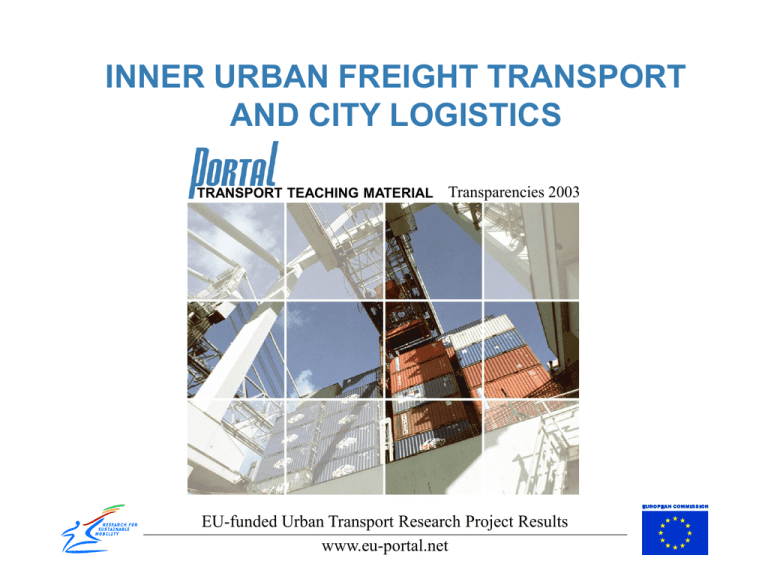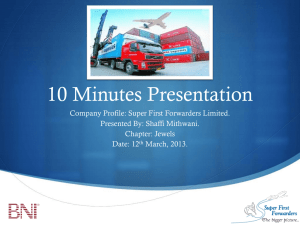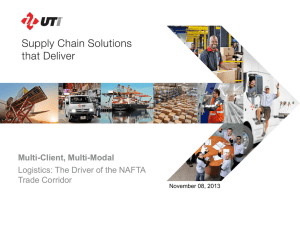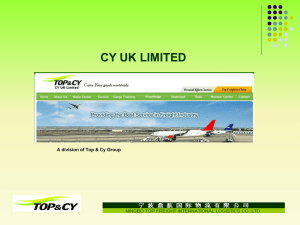INNER URBAN FREIGHT TRANSPORT AND CITY
advertisement

INNER URBAN FREIGHT TRANSPORT AND CITY LOGISTICS TRANSPORT TEACHING MATERIAL Transparencies 2003 EU-funded Urban Transport Research Project Results www.eu-portal.net INNER URBAN FREIGHT TRANSPORT AND CITY LOGISTICS URBAN FREIGHT TRANSPORT AS PART OF THE TRANSPORT CHAIN Chapter 1 INNER URBAN FREIGHT TRANSPORT AND CITY LOGISTICS OVERVIEW Introduction to logistics Specialities and problems of urban freight transport New trends in urban freight transport Chapter 1 INNER URBAN FREIGHT TRANSPORT AND CITY LOGISTICS LOGISTICS Logistics is that part of the supply chain process that plans, implements, and controls the efficient, effective flow and storage of goods, services, and related information from the point of origin to the point of consumption in order to meet customers’ requirements Chapter 2 INNER URBAN FREIGHT TRANSPORT AND CITY LOGISTICS IMPORTANCE OF CITY LOGISTIC High rate of urbanisation in Europe Delivery and supply of transport are very cost intensive Environmental sensitivity of urban areas • Air pollution • Noise emissions Economic competitivity of urban areas Chapter 2 INNER URBAN FREIGHT TRANSPORT AND CITY LOGISTICS COMPONENTS OF THE LOGISTICAL PROCESS PRODUCTION i.e. the qualitative change of a good DECONSOLIDATION i.e. shipments are united or dispersed STORAGE i.e. goods are stored until they are called for by consumers CONSUMPTION i.e. goods are consumed or further changed qualitatively DISPOSAL i.e. used goods are disposed as waste Chapter 2 INNER URBAN FREIGHT TRANSPORT AND CITY LOGISTICS PASSAGERS - GOODS Passangers Goods Travel (active) Must be loaded, unloaded and transferred Board, get off and transfer without assistance The information must be processed through logistics managers Process information and act on it without assistance Logistics managers meet choices between means of transport rationally Meet choices between means of transport without assistance but often irrationally Must be loaded, unloaded and transferred Chapter 2 INNER URBAN FREIGHT TRANSPORT AND CITY LOGISTICS SINGLE-STEP SYSTEM Chapter 2 INNER URBAN FREIGHT TRANSPORT AND CITY LOGISTICS MULTI-STEP SYSTEM Chapter 2 INNER URBAN FREIGHT TRANSPORT AND CITY LOGISTICS COMBINED SYSTEM Chapter 2 INNER URBAN FREIGHT TRANSPORT AND CITY LOGISTICS TRANSPORT CHAIN Sequence of technical and organisational interconnected events, by which goods are moved from an origin (supplier) to a destination (receiver) Chapter 2 INNER URBAN FREIGHT TRANSPORT AND CITY LOGISTICS ORGANISATION OF FREIGHT TRANSPORT Chapter 2 INNER URBAN FREIGHT TRANSPORT AND CITY LOGISTICS POSSIBLE TRANSPORT CHAINS Chapter 2 INNER URBAN FREIGHT TRANSPORT AND CITY LOGISTICS SPECIAL FEATURES OF URBAN FREIGHT TRANSPORT Spatial restrictions Traffic infrastructure Environmental concerns and sensitivities Chapter 3 INNER URBAN FREIGHT TRANSPORT AND CITY LOGISTICS RESEARCH ON FREIGHT TRANSPORT IN URBAN AREAS particularities of todays logistic processes research and development new concepts in city logistic todays processes future processes Chapter 3 strong constraints economical necessities negative macroeconomic effects positive macroeconomic effects political reglementations INNER URBAN FREIGHT TRANSPORT AND CITY LOGISTICS POSSIBILITIES FOR CITY DELIVERY Individual forms of organizations • Receivers without self-coordinated delivery logistics • Receivers with distribution company coordinated delivery logistics • Receivers with self-coordinated logistics Superordinated forms of public organizations • Goods distributions centres • Freight villages Chapter 3 INNER URBAN FREIGHT TRANSPORT AND CITY LOGISTICS RECEIVERS WITHOUT SELF-ORGANIZED LOGISTICS 1. Chapter 3 2. INNER URBAN FREIGHT TRANSPORT AND CITY LOGISTICS RECEIVERS WITH CO-ORDINATED LOGISTICS Chapter 3 INNER URBAN FREIGHT TRANSPORT AND CITY LOGISTICS LACK OF OVERSIGHT FOR THE ENTIRE SYSTEM Freight transport is normally based on rational decisions • One aspires to minimal operation cost Should lead to a reduced use of resources However, many transport processes are not optimal from a macroeconomic perspective • The several subsystems (involved companies) are too small • Subsystems are optimised under the constraint of business without taking into account the entire system Chapter 3 INNER URBAN FREIGHT TRANSPORT AND CITY LOGISTICS RELATIONSHIP BETWEEN TRIPS AND TONNAGE 100% 1% 11% 10% 80% 38% 60% Semi-trailers 40% 88% Trucks (> 3.5 to) Deliv ery v ans (< 3.5 to) 52% 20% 0% trips Chapter 3 tons INNER URBAN FREIGHT TRANSPORT AND CITY LOGISTICS SUBOPTIMAL TRANSPORT CHAINS FROM A MACROECONOMIC PERSPECTIVE Companies tend to avoid breakpoints in the transport chain Short-haul vehicles (e.g. vans) are used also for midlength and long stretches Combined transport (Rail - Road) is rarely used Chapter 3 INNER URBAN FREIGHT TRANSPORT AND CITY LOGISTICS NO FURTHER BUNDLING OF TRIPS No interest by the enterprises involved (receivers/distribution companies) company A • des Single enterprises are in competiton with one another company C company B with internal process optimisation city centre Chapter 3 • en Doesn‘t go along Incentive measures from the public a necessity INNER URBAN FREIGHT TRANSPORT AND CITY LOGISTICS POSSIBILITIES FOR OTPIMISATION New forms of Organisations • Goods distribution Centres • Freight villages New Technical Developments • New Transhipment Technologies • Smaller Containers in the Logistical Sphere Administrative Control Mechanisms • Creation of regulations • Taxation • Subsidy and infrastructure development Chapter 4 INNER URBAN FREIGHT TRANSPORT AND CITY LOGISTICS GOODS DISTRIBUTIONS CENTRE (City Terminal) At a Goods distribution centre all goods flows with destination city centre are consolidated and compiled to new loads. The aim of a city terminal is the Minimisation of the number of Delivery Chapter 4 Tips in City Centres. INNER URBAN FREIGHT TRANSPORT AND CITY LOGISTICS GOODS DISTRIBUTION CENTRES AND FREIGHT VILLAGES 1. 1 2 2. Function of a goods distribution center Functionaliy of a village with transhipment service Chapter 4 INNER URBAN FREIGHT TRANSPORT AND CITY LOGISTICS FREIGHT VILLAGES Freight villages are industry zones with the best connections to the transport network, where freight transport intensive enterprises, are established. Ideally, they have the equipment for the transhipment between different transport modes. Chapter 4 INNER URBAN FREIGHT TRANSPORT AND CITY LOGISTICS LOGISTICAL SERVICES AT A FREIGHT VILLAGE Chapter 4 • Long-distance transport • Distribution transport • Warehousing • Deconsolidation INNER URBAN FREIGHT TRANSPORT AND CITY LOGISTICS INFRASTRUCTURE AT A FREIGHT VILLAGE • Connections to the network (high capacity roads, railway network, waterways, etc.) • Transhipment services for intermodal transport • Branch lines • Environmental protection services Chapter 4 INNER URBAN FREIGHT TRANSPORT AND CITY LOGISTICS ADMINISTRATIVE AND TECHNICAL SERVICES AT A FREIGHT VILLAGE • Distribution service, in the sense of a city terminal • Garage for vehicles, containers and transhipment equipment • Offices for customs, road traffic • Safety services • Information services, communications services (i.e., conference rooms), consultancy services Chapter 4 INNER URBAN FREIGHT TRANSPORT AND CITY LOGISTICS NEW TRANSHIPMENT TECHNOLOGIES Why? • Cheaper transhipment • Separation of long distance transport and short distance transport • Adequate vehicles for short distance transport • Promotion of rail transport Chapter 4 INNER URBAN FREIGHT TRANSPORT AND CITY LOGISTICS NEW TRANSHIPMENT TECHNIQUES TO PROMOTE COMBINED TRANSPORT Chapter 4 INNER URBAN FREIGHT TRANSPORT AND CITY LOGISTICS SMALLER CONTAINERS IN THE LOGISTICS SHEPHE Why? • More adequate load units for supply and delivery • Cheaper deconsolidation • Long distance container = short distance container • No interruption in transport chain • Better degree of utilisation of the loading capacity Chapter 4 INNER URBAN FREIGHT TRANSPORT AND CITY LOGISTICS SMALLER CONTAINERS Chapter 4 INNER URBAN FREIGHT TRANSPORT AND CITY LOGISTICS ADMINISTRATIVE CONTROL MECHANISMS Creation of regulations • Weight • Emission • Delivery times • Access roads • Loading zones Taxation Subsidy and infrastructure development Chapter 4







